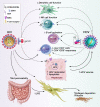Coinfection with hepatitis C virus and human immunodeficiency virus: virological, immunological, and clinical outcomes
- PMID: 19420073
- PMCID: PMC2708610
- DOI: 10.1128/JVI.00191-09
Coinfection with hepatitis C virus and human immunodeficiency virus: virological, immunological, and clinical outcomes
Figures

References
-
- Albert, M. L., J. Decalf, and S. Pol. 2008. Plasmacytoid dendritic cells move down on the list of suspects: in search of the immune pathogenesis of chronic hepatitis C. J. Hepatol. 491069-1078. - PubMed
-
- Alter, M. J. 2006. Epidemiology of viral hepatitis and HIV co-infection. J. Hepatol. 44S6-9. - PubMed
-
- Antonucci, G., E. Girardi, A. Cozzi-Lepri, M. R. Capobianchi, A. De Luca, M. Puoti, E. Petrelli, G. Carnevale, G. Rizzardini, P. A. Grossi, P. Vigano, M. C. Moioli, F. Carletti, M. Solmone, G. Ippolito, and A. D. Monforte. 2005. Role of hepatitis C virus (HCV) viremia and HCV genotype in the immune recovery from highly active antiretroviral therapy in a cohort of antiretroviral-naive HIV-infected individuals. Clin. Infect. Dis. 40e101-e109. - PubMed
-
- Antonucci, G., D. Goletti, S. Lanini, E. Girardi, and O. Loiacono. 2003. HIV/HCV co-infection: putting the pieces of the puzzle together. Cell Death Differ. 10S25-S26. - PubMed
-
- Aranzabal, L., J. L. Casado, J. Moya, C. Quereda, S. Diz, A. Moreno, L. Moreno, A. Antela, M. J. Perez-Elias, F. Dronda, A. Marin, F. Hernandez-Ranz, A. Moreno, and S. Moreno. 2005. Influence of liver fibrosis on highly active antiretroviral therapy-associated hepatotoxicity in patients with HIV and hepatitis C virus coinfection. Clin. Infect. Dis. 40588-593. - PubMed
Publication types
MeSH terms
LinkOut - more resources
Full Text Sources
Medical

